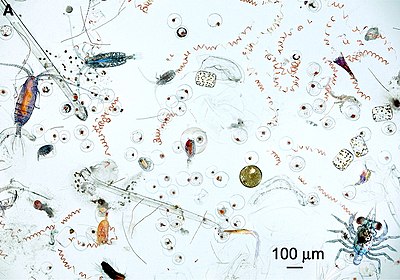
Back Plankton Afrikaans Plankton ALS عوالق Arabic Plancton AST Plankton Azerbaijani Планктон Byelorussian Плянктон BE-X-OLD Планктон Bulgarian প্ল্যাঙ্কটন Bengali/Bangla Plankton Breton

Plankton are the diverse collection of organisms that drift in water (or air) but are unable to actively propel themselves against currents (or wind).[1][2] The individual organisms constituting plankton are called plankters.[3] In the ocean, they provide a crucial source of food to many small and large aquatic organisms, such as bivalves, fish, and baleen whales.
Marine plankton include bacteria, archaea, algae, protozoa, microscopic fungi,[4] and drifting or floating animals that inhabit the saltwater of oceans and the brackish waters of estuaries. Freshwater plankton are similar to marine plankton, but are found in lakes and rivers. Mostly plankton just drift where currents take them, though some, like jellyfish, swim slowly but not fast enough to generally gain control from the influence of currents.
Although plankton are usually thought of as inhabiting water, there are also airborne versions that live part of their lives drifting in the atmosphere. These aeroplankton include plant spores, pollen and wind-scattered seeds. They may also include microorganisms swept into the air from terrestrial dust storms and oceanic plankton swept into the air by sea spray.
Though many planktonic species are microscopic in size, plankton includes organisms over a wide range of sizes, including large organisms such as jellyfish.[5] This is because plankton are defined by their ecological niche and level of motility rather than by any phylogenetic or taxonomic classification. The "plankton" category differentiates these organisms from those that float on the water's surface, called neuston, those that can swim against a current, called nekton, and those that live on the deep sea floor, called benthos.
- ^ Lalli, C.; Parsons, T. (1993). Biological Oceanography: An Introduction. Butterworth-Heinemann. ISBN 0-7506-3384-0.
- ^ Smith, David J. (July 2013). "Aeroplankton and the Need for a Global Monitoring Network". BioScience. 63 (7): 515–516. doi:10.1525/bio.2013.63.7.3. S2CID 86371218.
- ^ "plankter". American Heritage Dictionary. Houghton Mifflin Harcourt Publishing Company. Archived from the original on 9 November 2018. Retrieved 9 November 2018.
- ^ Lawton, Graham (10 February 2024). "Fungi ahoy!". New Scientist. 261 (3477): 37–39. doi:10.1016/S0262-4079(24)00274-4.
- ^ Dolan, John (November 2012). "Microzooplankton: the microscopic (micro) animals (zoo) of the plankton" (PDF). Institut océanographique. Archived from the original (PDF) on 4 March 2016. Retrieved 16 January 2014.
© MMXXIII Rich X Search. We shall prevail. All rights reserved. Rich X Search